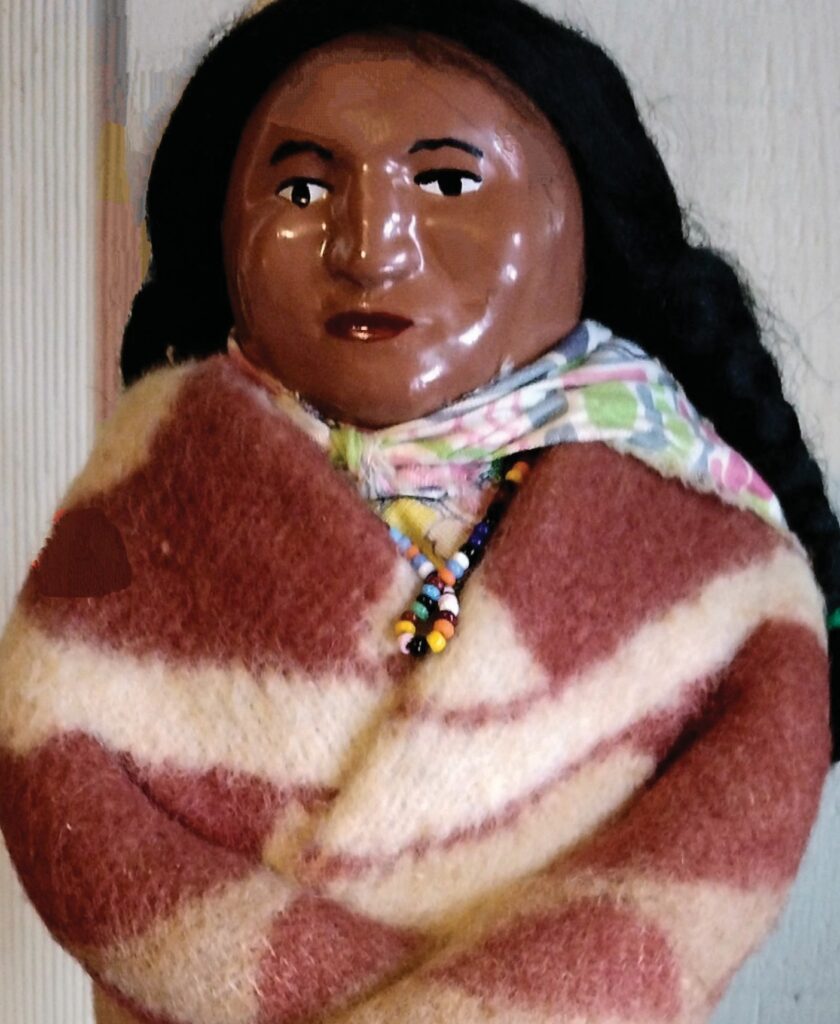Doll Making – A Sacred Journey of Culture and Connection
With the holidays upon us, many gift givers look for the perfect doll as a child’s play companion or for an adult to display as art, but what makes doll making sacred?
From ancient times, dolls were fashioned from grass, straw, wood, clay, fabrics, dried apples, and stone for a multitude of purposes. The kachina of the Hopi represent spirits, while the feminine clay figurines of old Europe represent qualities of motherhood, such as fertility, and desirable virtues to be achieved.
The modern doll maker comes from a long history of artisans, clothiers, spiritual holy people, and others, deeply embedded in a place, a people, and their traditions. Dolls are often dressed in regalia, such as the ornate creation Ghost Dancer, ca. 2008, by Cheyenne River Sioux/Lakota doll maker, Rhonda Holy Bear, sculpted from wood and adorned with hide, glass beads, feathers, hair, dentalium shells, and pigment paints. Assiniboine Sioux, Joyce Growing Thunder, detailed her wood sculpted doll named Ben Grey Hawk, ca. 2001, with shell, porcupine quills, ermine, metal, cloth, hide, hair, glass beads and pigment. Still others add traditional elements such as bird feathers and talons to complete the ensemble, evoking cultural and place-based significance, forming a binding connection between the doll holder, the doll, and Grandmother Earth.
Through doll making, the sacred colors, symbolism, and historical knowledge is frozen in time and passed on to future generations. The artist may spend decades researching and carefully examining the tiniest details of artifacts and regalia, attending cultural events over many years and listening to stories from elders to gain the knowledge they require before embarking on the physical creation of a doll.
Nothing is wasted in the doll maker’s cache of supplies. The smallest scrap of cloth or hide, the most delicate little shell or tiny feather, broken tips off of dentalium shells or a tuft of buffalo fur, a mother-of-pearl button off an old hand me down, or a miniscule bit of ribbon, leftover beads and quills, mismatched earrings, or a shiny piece of metal can all be repurposed to adorn a doll.
A doll maker knows all too well the connection each doll has with the land, the earth,water and sky. A fallen branch or broken wooden table leg can be sculpted into a doll. A broken chunk of stone can be formed into a doll’s hands or face. The Hopi searched for the wood from the cottonwood tree from which to carve their kachina dolls.
Doll makers from agricultural or foraging tribes often used the plants they grew or gathered to make household items like baskets, containers, clothing and bedding, dolls, and adornments. Among those who grew corn, beans, and squash – the three sisters – as well as fruit trees, were artisans who used corn husks or dried apples to fashion dolls, such as Eastern Band Cherokee artist Laura Walkingstick, who teaches teens and children to make corn husk dolls. Walkingstick encourages budding student crafters to explore their personal experiences, telling their own stories through hands-on doll making, in an effort to address trauma.
Dolls can tell stories, reflect and inspire virtues, encapsulate an era, depict historical figures, preserve traditional arts and teach us to accept ourselves or overcome obstacles, putting the pain of the past behind us and bringing the lessons of our ancestors forward into the present and beyond.
(In addition to writing, Aliyah is a former beadworker, jewelry maker, sculptor, painter, tailor, and antique furniture restorer. Her grandmother, Minnie Hardman Roberts was a photographer, seamstress, and artist who painted China plates and bisque porcelain dolls from the age of 81-91.)
Contact info: kestreldancing@gmail.com
The post Doll Making – A Sacred Journey of Culture and Connection first appeared on Native Sun News Today.
Tags: More News

